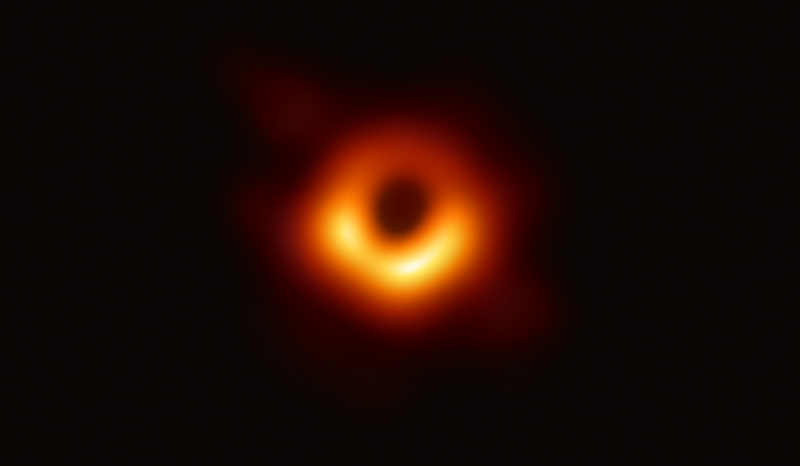There’s been just a little excitement about the latest findings of the Event Horizon Telescope (EHT) not the least of which is that they’ve actually got a picture of a black hole. And, to quote my wife, “When I check Facebook and all of my theatre friends are posting about black holes I know it’s an exciting day in science.”
Now, while I work on black holes, the photons that I use to study them are carry about a million times more energy per photon than the ~mm radio photons that are used by the EHT. Even so, let’s try to break out what’s cool and exciting about this new result.
How on Earth do you see all the way down?
The answer here is, actually, “Use the whole Earth”. One of the amazing things about radio telescopes is that you can combine data from multiple telescopes to mimic the magnifying power of a single, large telescope. The is called “interferometry” and has been used in the radio for decades to create amazingly high resolution images using “very-long-baseline” interferometry. The EHT takes this to extremes by combining nearly ever sub-mm radio telescope on the planet to make an “Earth-sized” radio telescope. They EHT website has a nice Google maps overlay that lets you track down all of the telescopes, which more or less span western hemisphere (all of the telescopes have to be observing at the same time for this to work, so you have to be on the same side of the Earth).

There are new telescopes joining the EHT all the time, including another one in Greenland. You may notice that there’s also one way down at the bottom at the South Pole, which has its own difficulties.
How do you combine data from multiple telescopes spread over the world?
The data from radio telescopes is a digitized signal of the radio waves being recorded by each radio observatory. In cases like the VLA (from Contact) you can combine the signals locally. In this case, you’ve got to bring all of the data together into a single location in order to combine the data in a supercomputer to get the signal out. And this is a LOT of data
But seriously, how much data?
A lot. For just the one observation you’re talking about 5 Petabytes of data (5,000 terabytes). So you’d need about 2,500 storage drives like the 2 TB drive that’s backing up my computer to store all of that data. Which is absurd. And it’s just for one set of observations. You obviously can’t send that much data over the internet, which means that you need to physical carry the hard drives from each telescope to the central computer. Which again, makes getting your data from the South Pole Telescope a bit of a challenge.
So, what do you buy with all of this data?
Resolution. We’re way beyond “human hair” at a mile away stuff here. The EHT has the resolving power so that if you were in Los Angeles you could read the date stamp off a coin in New York.
In astronomical terms, this means that you make extremely fine images of very small things. Like supermassive black holes at the centers of galaxies.
Wait, black holes are small?
Yes! Even though they’re massive, the size of the black hole event horizon (which gives the EHT its name) is pretty tiny compared to the size of a galaxy. Some perspective:
The distance from the Earth to the Sun is defined to be “1 Astronomical Unit” or 1 AU. The Milky Way is about 100,000 lightyears across, which means that it’s about 6 trillion AU across. The size of the event horizon for the black at the center of our galaxy is only about 1 AU (by coincidence). So you’re looking at something that is teeny tiny compared to the size of the galaxy itself. Which means that if you want to image it, you need the resolving power of the EHT.
Okay, okay, show me pictures
First, let’s talk about what we’re actually seeing here. The galaxy that the EHT is looking at is called “M87”, which is a relatively nearby elliptical galaxy with a diameter about 20% larger than the Milky Way at a distance of roughly 55 million light years (basically down the street in the neighborhood of nearby galaxies). It’s also got a massive black hole at its center. This is actually important because the size of the event horizon scales like the mass of the black hole. So even though this galaxy is pretty far away, because it is so heavy its event horizon is still large enough for the EHT to see. Which they did. Which is awesome.

What you’re seeing in yellow is the material being eaten by the massive black hole, which don’t see directly, but you can see its shadow in the center of the image. The image itself represents a region of space roughly comparable to the size of our solar system but at a distance of 55 million light years, which are numbers so large that it’s hard to cast them in any way that make sense on a human scale.
There’s a ton of stuff to learn about the black hole here and I’m not in a great position to even know what the right questions are to ask here. Thankfully, there’s a whole free special issue in The Astrophysical Journal dealing just with these observation. I’m sure we’ll see more soon.

Leave a Reply